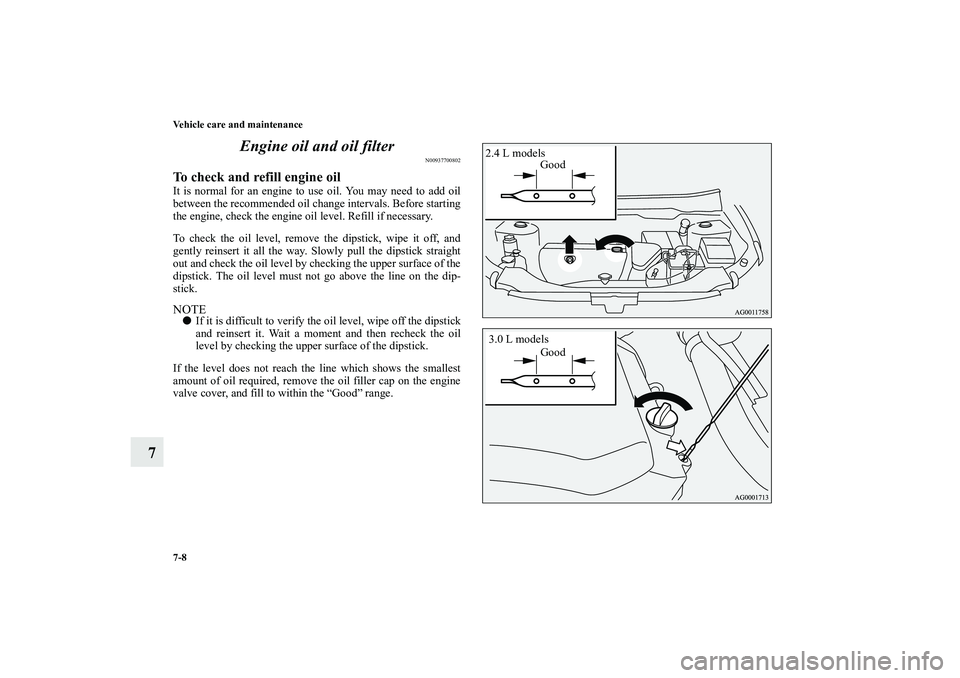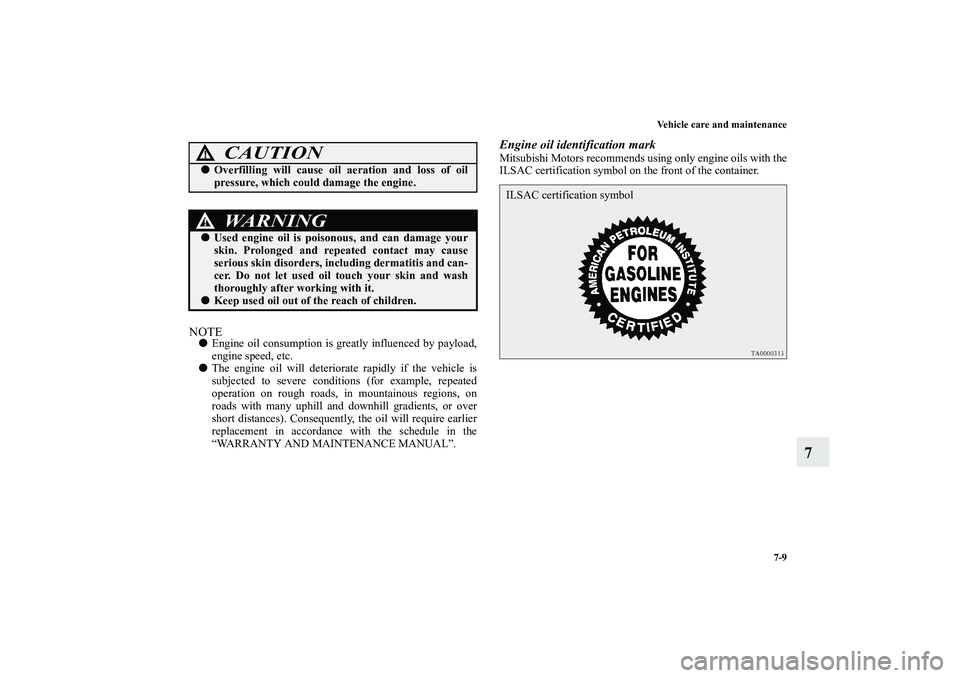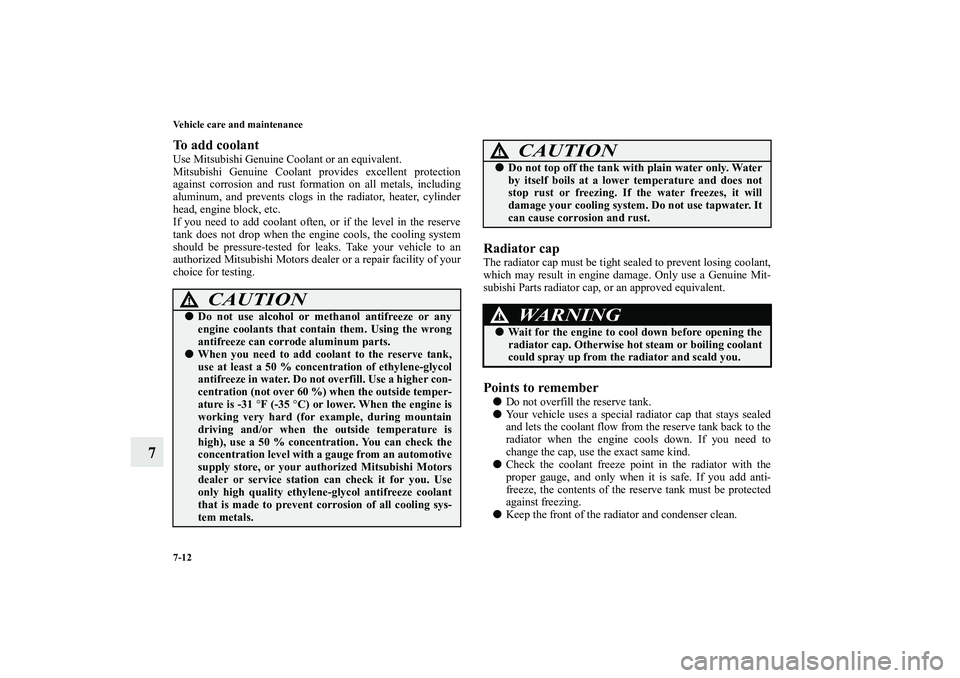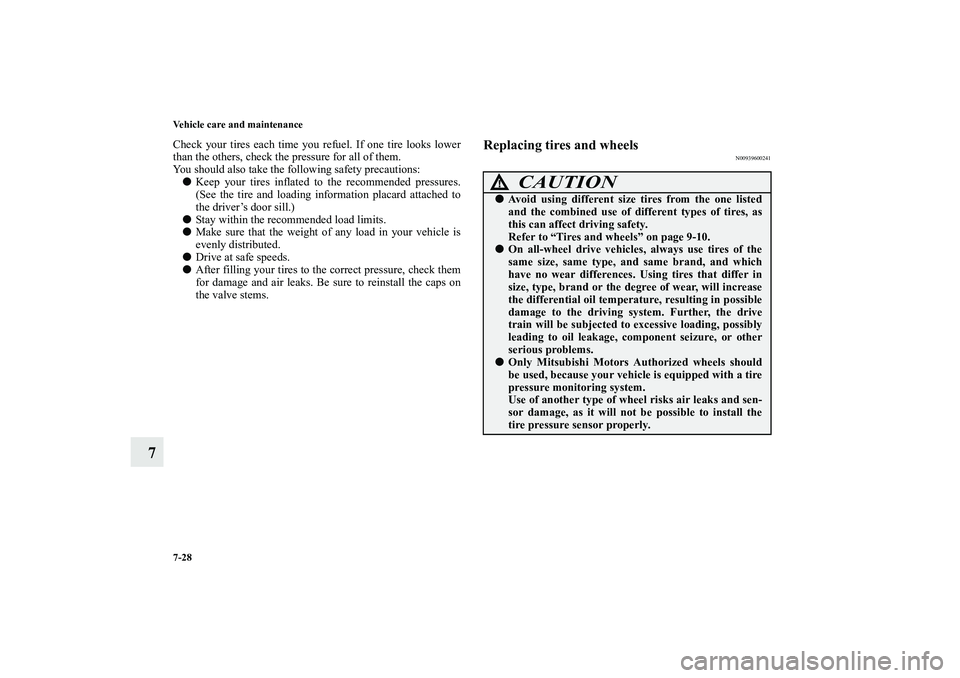Page 604 of 714
Vehicle care and maintenance
7-7
7 View of the engine compartment
N00937600579
2.4 L models 3.0 L models
1- Power steering fluid reservoir
2- Air cleaner filter
3- Brake fluid tank
4- Engine coolant reserve tank
5- Windshield and rear window washer fluid reservoir
6- Engine oil level dipstick
7- Engine oil filler cap
8- Radiator cap
9- Automatic transaxle fluid level dipstick
10- Battery
BK0115300US.book 7 ページ 2009年7月16日 木曜日 午前9時13分
Page 605 of 714

7-8 Vehicle care and maintenance
7Engine oil and oil filter
N00937700802
To check and refill engine oilIt is normal for an engine to use oil. You may need to add oil
between the recommended oil change intervals. Before starting
the engine, check the engine oil level. Refill if necessary.
To check the oil level, remove the dipstick, wipe it off, and
gently reinsert it all the way. Slowly pull the dipstick straight
out and check the oil level by checking the upper surface of the
dipstick. The oil level must not go above the line on the dip-
stick.NOTE�
If it is difficult to verify the oil level, wipe off the dipstick
and reinsert it. Wait a moment and then recheck the oil
level by checking the upper surface of the dipstick.
If the level does not reach the line which shows the smallest
amount of oil required, remove the oil filler cap on the engine
valve cover, and fill to within the “Good” range.
2.4 L models
Good
Good 3.0 L models
BK0115300US.book 8 ページ 2009年7月16日 木曜日 午前9時13分
Page 606 of 714

Vehicle care and maintenance
7-9
7
NOTE�
Engine oil consumption is greatly influenced by payload,
engine speed, etc.
�
The engine oil will deteriorate rapidly if the vehicle is
subjected to severe conditions (for example, repeated
operation on rough roads, in mountainous regions, on
roads with many uphill and downhill gradients, or over
short distances). Consequently, the oil will require earlier
replacement in accordance with the schedule in the
“WARRANTY AND MAINTENANCE MANUAL”.
Engine oil identification markMitsubishi Motors recommends using only engine oils with the
ILSAC certification symbol on the front of the container.
CAUTION
!�
Overfilling will cause oil aeration and loss of oil
pressure, which could damage the engine.WA R N I N G
!�
Used engine oil is poisonous, and can damage your
skin. Prolonged and repeated contact may cause
serious skin disorders, including dermatitis and can-
cer. Do not let used oil touch your skin and wash
thoroughly after working with it.
�
Keep used oil out of the reach of children.
ILSAC certification symbol
BK0115300US.book 9 ページ 2009年7月16日 木曜日 午前9時13分
Page 607 of 714
7-10 Vehicle care and maintenance
7
If you cannot find oils with the ILSAC certification symbol,
use an API classification SM oil with the following label.
This mark appears on the top of the oil container and tells you
two important things about the oil.
Recommended engine oil viscosityUse engine oil with the proper thickness for the outdoor tem-
peratures where you will be driving.
SAE 5W-20 engine oil is strongly recommended for optimum
fuel economy and cold starting.
SAE 10W-30 may be used when the normal operationg tem-
perature is above 100 °F (38 °C).
1- The upper part indicates the quality of the oil.
2- The center part indicates the SAE grade of the oil viscosity.API service symbol
BK0115300US.book 10 ページ 2009年7月16日 木曜日 午前9時13分
Page 608 of 714
Vehicle care and maintenance
7-11
7
To replace the oil filterThe oil filter should be replaced at the time or mileage speci-
fied in the “WARRANTY AND MAINTENANCE MAN-
UAL”.
Only use high quality replacement filters on this vehicle. The
manufacturer’s specifications for Genuine Mitsubishi oil filters
require that the filter can withstand a pressure of 256 psi (1.8
MPa). A Genuine Mitsubishi oil filter is the best replacement
filter.
Follow the installation instructions printed on the filter.
Engine coolant
N00937800425
To check the coolant levelThe engine coolant reserve tank (A) lets you quickly see when
you need to add coolant. When the engine is cold, the level of
the coolant in the reserve tank should be between the FULL
and LOW marks. The radiator usually stays full so there is no
reason to remove the radiator cap (B) except when you check
the coolant freeze point or replace the antifreeze coolant.FULL
LOW
BK0115300US.book 11 ページ 2009年7月16日 木曜日 午前9時13分
Page 609 of 714

7-12 Vehicle care and maintenance
7
To add coolantUse Mitsubishi Genuine Coolant or an equivalent.
Mitsubishi Genuine Coolant provides excellent protection
against corrosion and rust formation on all metals, including
aluminum, and prevents clogs in the radiator, heater, cylinder
head, engine block, etc.
If you need to add coolant often, or if the level in the reserve
tank does not drop when the engine cools, the cooling system
should be pressure-tested for leaks. Take your vehicle to an
authorized Mitsubishi Motors dealer or a repair facility of your
choice for testing.
Radiator capThe radiator cap must be tight sealed to prevent losing coolant,
which may result in engine damage. Only use a Genuine Mit-
subishi Parts radiator cap, or an approved equivalent.Points to remember�
Do not overfill the reserve tank.
�
Your vehicle uses a special radiator cap that stays sealed
and lets the coolant flow from the reserve tank back to the
radiator when the engine cools down. If you need to
change the cap, use the exact same kind.
�
Check the coolant freeze point in the radiator with the
proper gauge, and only when it is safe. If you add anti-
freeze, the contents of the reserve tank must be protected
against freezing.
�
Keep the front of the radiator and condenser clean.
CAUTION
!�
Do not use alcohol or methanol antifreeze or any
engine coolants that contain them. Using the wrong
antifreeze can corrode aluminum parts.
�
When you need to add coolant to the reserve tank,
use at least a 50 % concentration of ethylene-glycol
antifreeze in water. Do not overfill. Use a higher con-
centration (not over 60 %) when the outside temper-
ature is -31 °F (-35 °C) or lower. When the engine is
working very hard (for example, during mountain
driving and/or when the outside temperature is
high), use a 50 % concentration. You can check the
concentration level with a gauge from an automotive
supply store, or your authorized Mitsubishi Motors
dealer or service station can check it for you. Use
only high quality ethylene-glycol antifreeze coolant
that is made to prevent corrosion of all cooling sys-
tem metals.
�
Do not top off the tank with plain water only. Water
by itself boils at a lower temperature and does not
stop rust or freezing. If the water freezes, it will
damage your cooling system. Do not use tapwater. It
can cause corrosion and rust.WA R N I N G
!�
Wait for the engine to cool down before opening the
radiator cap. Otherwise hot steam or boiling coolant
could spray up from the radiator and scald you.CAUTION
!
BK0115300US.book 12 ページ 2009年7月16日 木曜日 午前9時13分
Page 615 of 714
7-18 Vehicle care and maintenance
7Transfer oil (All-wheel drive models)
N00938400196
Whenever the transfer oil level is checked, add oil as necessary
to maintain the proper level. Fill or change the oil according to
the table.Fluid type
Rear axle oil (All-wheel drive models)
N00915200197
Whenever the oil level is checked, add oil as necessary to
maintain the proper level.
Fill or change oil according to the table.Fluid type
Lubricant Hypoid gear oil API classification GL-5
Viscosity range SAE 80 or 90
Lubricant Hypoid gear oil API classification GL-5
Viscosity range SAE 80
BK0115300US.book 18 ページ 2009年7月16日 木曜日 午前9時13分
Page 625 of 714

7-28 Vehicle care and maintenance
7
Check your tires each time you refuel. If one tire looks lower
than the others, check the pressure for all of them.
You should also take the following safety precautions:�
Keep your tires inflated to the recommended pressures.
(See the tire and loading information placard attached to
the driver’s door sill.)
�
Stay within the recommended load limits.
�
Make sure that the weight of any load in your vehicle is
evenly distributed.
�
Drive at safe speeds.
�
After filling your tires to the correct pressure, check them
for damage and air leaks. Be sure to reinstall the caps on
the valve stems.
Replacing tires and wheels
N00939600241
CAUTION
!�
Avoid using different size tires from the one listed
and the combined use of different types of tires, as
this can affect driving safety.
Refer to “Tires and wheels” on page 9-10.
�
On all-wheel drive vehicles, always use tires of the
same size, same type, and same brand, and which
have no wear differences. Using tires that differ in
size, type, brand or the degree of wear, will increase
the differential oil temperature, resulting in possible
damage to the driving system. Further, the drive
train will be subjected to excessive loading, possibly
leading to oil leakage, component seizure, or other
serious problems.
�
Only Mitsubishi Motors Authorized wheels should
be used, because your vehicle is equipped with a tire
pressure monitoring system.
Use of another type of wheel risks air leaks and sen-
sor damage, as it will not be possible to install the
tire pressure sensor properly.
BK0115300US.book 28 ページ 2009年7月16日 木曜日 午前9時13分